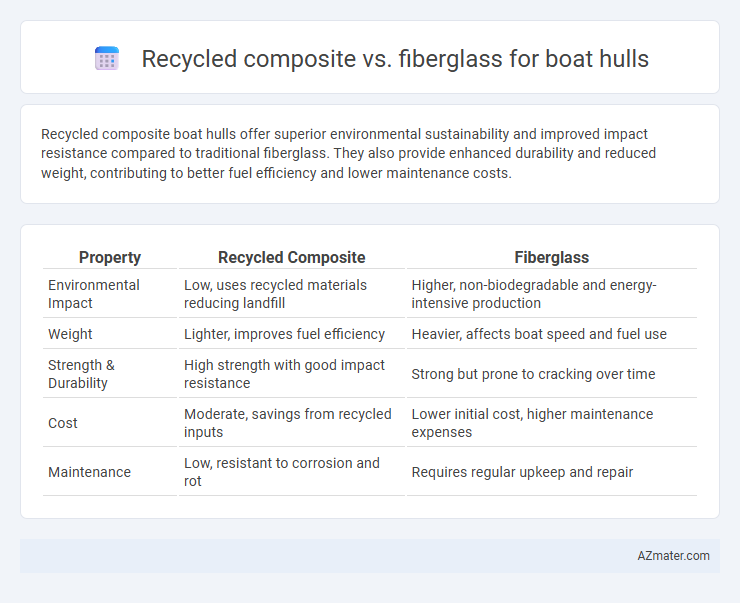Recycled composite boat hulls offer superior environmental sustainability and improved impact resistance compared to traditional fiberglass. They also provide enhanced durability and reduced weight, contributing to better fuel efficiency and lower maintenance costs.
Table of Comparison
| Property | Recycled Composite | Fiberglass |
|---|---|---|
| Environmental Impact | Low, uses recycled materials reducing landfill | Higher, non-biodegradable and energy-intensive production |
| Weight | Lighter, improves fuel efficiency | Heavier, affects boat speed and fuel use |
| Strength & Durability | High strength with good impact resistance | Strong but prone to cracking over time |
| Cost | Moderate, savings from recycled inputs | Lower initial cost, higher maintenance expenses |
| Maintenance | Low, resistant to corrosion and rot | Requires regular upkeep and repair |
Introduction: The Evolution of Boat Hull Materials
Recycled composite boat hulls represent a significant advancement in sustainable marine construction, offering enhanced environmental benefits over traditional fiberglass. Fiberglass has dominated boat hull manufacturing due to its strength and durability, but its ecological impact prompts the search for greener alternatives. The evolution towards recycled composites integrates waste materials and improved performance, marking a pivotal shift in boat hull technology.
Overview of Recycled Composite Materials for Boat Hulls
Recycled composite materials for boat hulls offer a sustainable alternative to traditional fiberglass by repurposing waste plastics, carbon fibers, and other industrial byproducts into durable, lightweight structures. These composites exhibit enhanced corrosion resistance, reduced environmental impact, and comparable strength-to-weight ratios, making them increasingly popular in eco-conscious marine manufacturing. Innovations in resin technology and fiber reinforcement enable recycled composites to meet stringent performance standards required for boat hull durability and safety.
Traditional Fiberglass: Properties and Performance
Traditional fiberglass boat hulls offer a high strength-to-weight ratio and excellent durability, making them a popular choice in the marine industry for decades. The composite material consists of glass fibers embedded in a resin matrix, providing resistance to corrosion, impact, and fatigue in harsh marine environments. Fiberglass hulls deliver reliable structural integrity and ease of repair while maintaining performance and longevity under varying sea conditions.
Environmental Impact: Recycled Composites vs Fiberglass
Recycled composites for boat hulls significantly reduce environmental impact by utilizing reclaimed materials, thereby decreasing the demand for virgin resources and minimizing landfill waste. Fiberglass production involves energy-intensive processes and releases toxic emissions, contributing to pollution and long-term waste disposal challenges. Choosing recycled composites enhances sustainability by lowering carbon footprints and promoting circular economy practices in marine manufacturing.
Strength and Durability Comparison
Recycled composite boat hulls often demonstrate superior strength-to-weight ratios compared to traditional fiberglass, offering enhanced impact resistance and fatigue performance. These materials incorporate reclaimed fibers and resins that improve durability by resisting corrosion, UV damage, and water absorption better than conventional fiberglass. Over time, recycled composites maintain structural integrity with less maintenance, making them a sustainable yet robust alternative for marine applications.
Weight Differences and Performance Implications
Recycled composite boat hulls typically weigh 10-20% less than traditional fiberglass hulls, improving fuel efficiency and speed due to reduced mass. The lower density materials in recycled composites offer enhanced stiffness-to-weight ratios, resulting in better handling and responsiveness in various water conditions. Performance implications include increased acceleration and maneuverability, though long-term durability depends on resin quality and composite structure.
Cost Analysis: Upfront and Lifecycle Expenses
Recycled composite boat hulls typically present a higher upfront cost compared to fiberglass due to advanced material processing and limited manufacturing scale. Lifecycle expenses for recycled composites can be lower because of their enhanced durability, reduced maintenance needs, and better resistance to environmental degradation. Fiberglass hulls incur lower initial costs but often require more frequent repairs, coatings, and eventual replacement, increasing total ownership expenses over time.
Maintenance Requirements and Longevity
Recycled composite boat hulls offer superior resistance to corrosion, UV damage, and water absorption compared to traditional fiberglass, resulting in lower maintenance requirements over time. Fiberglass hulls typically require regular inspections for gelcoat cracks, osmosis, and potential delamination, demanding periodic sanding, repainting, and repairs. Longevity of recycled composite hulls often exceeds fiberglass, benefiting from enhanced material durability and environmental resilience, which extends the vessel's operational lifespan.
Innovations and Future Trends in Boat Hull Materials
Recycled composite materials offer significant innovations in sustainability and weight reduction compared to traditional fiberglass, enhancing fuel efficiency and lowering environmental impact in boat hull manufacturing. Advances in bio-based resins and enhanced fiber reinforcements are driving future trends, promoting stronger, lighter, and more eco-friendly hulls. The marine industry increasingly adopts recycled composites to meet rigorous performance standards while addressing regulatory pressures for greener materials in boat construction.
Choosing the Right Material: Factors for Boat Owners
Recycled composite boat hulls offer environmental benefits and enhanced durability with resistance to corrosion and UV damage, making them ideal for eco-conscious boat owners seeking longevity. Fiberglass remains popular due to its lightweight properties, ease of repair, and cost-effectiveness, appealing to owners prioritizing performance and budget. Key factors for boat owners include weight tolerance, maintenance requirements, environmental impact, and long-term cost efficiency when choosing between recycled composites and fiberglass.

Infographic: Recycled composite vs Fiberglass for Boat hull
 azmater.com
azmater.com